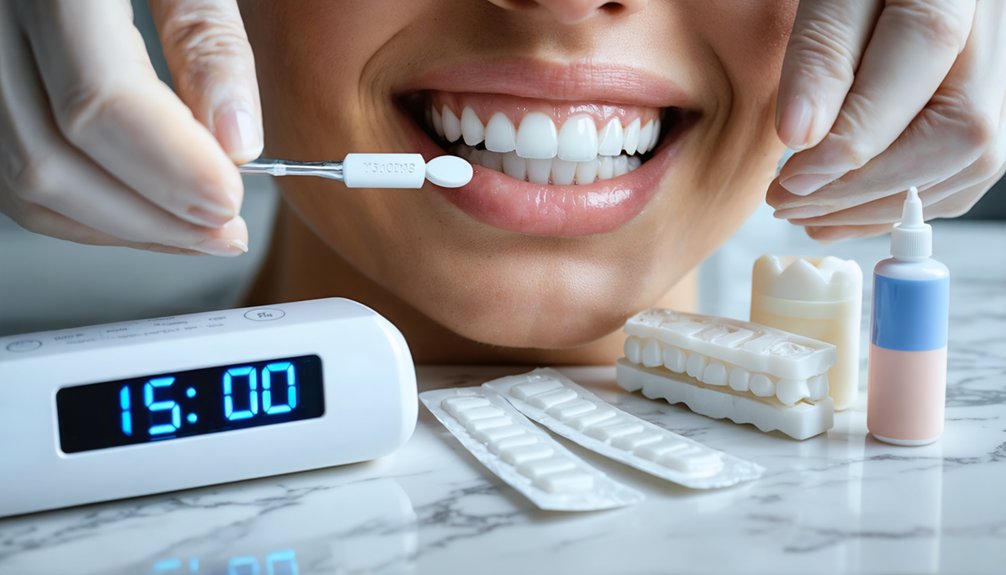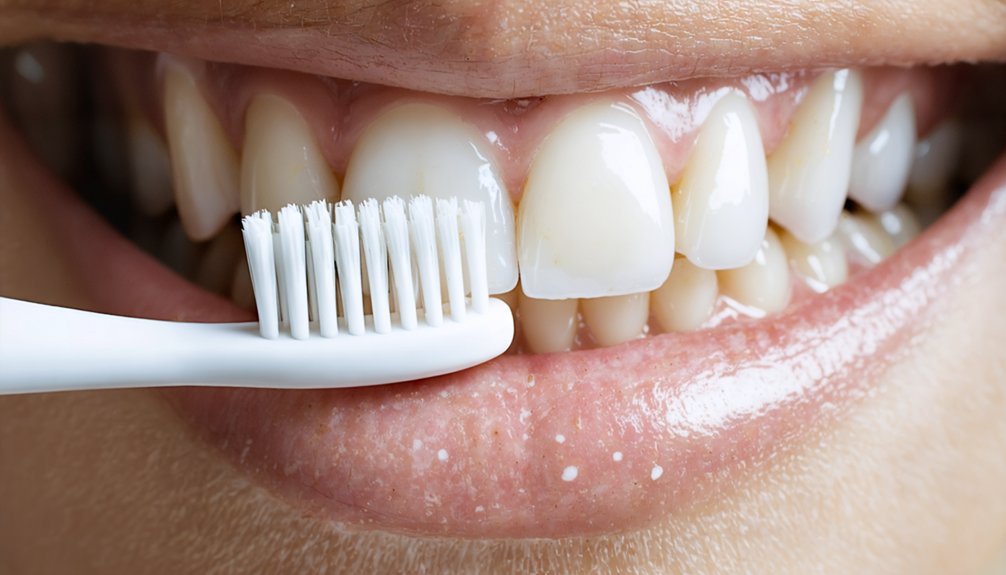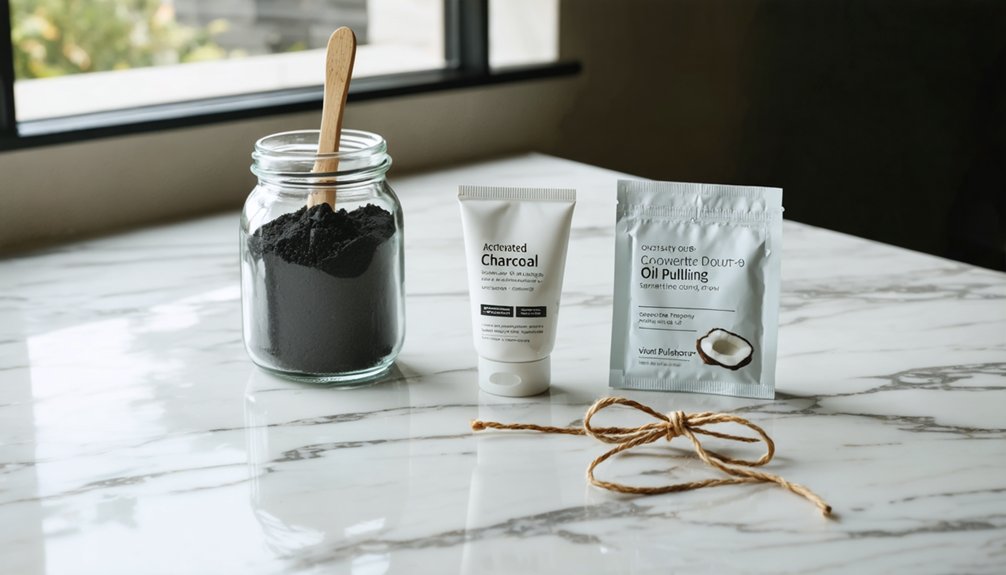For sensitive teeth, you’ll need a strategic whitening approach that prioritizes nerve protection while achieving aesthetic results. Start with desensitizing agents containing potassium nitrate two weeks before treatment, then select products with lower peroxide concentrations (15-20%). Incorporate specialized desensitizing gels between sessions and maintain strict oral hygiene with fluoride-based products. Professional consultation can determine your ideal treatment protocol, while understanding key sensitivity factors will maximize your whitening success.
Key Takeaways
- Use whitening products specially formulated for sensitive teeth with lower peroxide concentrations and built-in desensitizing agents.
- Start using potassium nitrate desensitizing toothpaste two weeks before whitening treatment to minimize discomfort.
- Choose professional custom trays over high-concentration treatments for gradual, controlled whitening with less sensitivity.
- Space out whitening sessions adequately to allow teeth recovery time and prevent prolonged sensitivity.
- Avoid acidic foods, extreme temperatures, and harsh brushing during the whitening process to protect sensitive teeth.
Understanding Tooth Sensitivity and Its Impact on Whitening
While tooth whitening remains a popular cosmetic procedure, patients with dental sensitivity require special consideration before proceeding with treatment. Affecting over 12% of adults, tooth sensitivity occurs when exposed dentinal tubules transmit thermal, chemical, or tactile stimuli directly to nerve endings in the pulp.
This condition greatly impacts lifestyle, causing sharp pain during routine activities like drinking hot beverages or breathing cold air. Common causes of sensitivity include gingival recession, enamel erosion, and bruxism, with many patients experiencing symptoms for over two years. A concerning 98% of study participants showed signs of dental erosion, highlighting the widespread nature of this condition. Visual analog scales are commonly used by dental professionals to assess and document pain levels in sensitive teeth.
Women and younger adults report higher incidence rates. Before pursuing whitening treatments, it’s essential to understand that sensitivity can worsen when teeth are exposed to whitening agents, potentially compromising your daily activities and oral care routine.
Professional Whitening Options for Sensitive Teeth
When treating patients with sensitive teeth, professional whitening options provide carefully controlled methods that can achieve ideal results while minimizing discomfort.
In-office treatments utilize high-concentration hydrogen peroxide gels (up to 35%) under strict supervision, while custom trays offer a more gradual approach using professional gels at lower concentrations. The use of specialized techniques helps patients with exposed dentin tubules. Professional methods are particularly effective since they provide fast, dramatic results.
To maximize comfort, dentists implement advanced techniques including pre-treatment protocols with desensitizing agents containing potassium nitrate or fluoride.
These treatments can begin 1-2 weeks before whitening to block nerve pathways and strengthen enamel. During sessions, buffering agents neutralize acidity, while temperature control and precise timing prevent sensitivity spikes.
For optimal protection, your dentist may apply protective coatings between treatments and carefully monitor your progress, adjusting concentrations and exposure times based on your individual sensitivity level.
At-Home Whitening Methods That Won’t Trigger Pain
You’ll discover multiple at-home options for whitening sensitive teeth through gentle DIY solutions that minimize discomfort while delivering gradual results.
Your success depends on selecting products specifically formulated with desensitizing agents, such as potassium nitrate or strontium acetate, which help protect nerve endings during the whitening process.
Natural solutions like baking soda mixtures provide a gentler alternative to traditional bleaching methods while still effectively removing surface stains. LED technology offers an innovative approach, with eight-minute treatments helping to speed up the whitening process while reducing sensitivity risks.
Gentle DIY Whitening Solutions
For individuals with sensitive teeth, several gentle at-home whitening solutions can effectively brighten your smile without triggering discomfort.
Natural whitening agents like diluted hydrogen peroxide rinses and carefully measured baking soda provide gentle exfoliation techniques that won’t compromise enamel integrity. You’ll find traditional remedies like coconut oil pulling and sage extract can support your whitening goals while soothing sensitive gums. For optimal safety, limit baking soda use to once or twice weekly.
To maximize results while minimizing sensitivity, incorporate specialized whitening toothpastes containing nerve-calming compounds and fluoride. Consulting with your dentist before starting any whitening regimen ensures you select products for sensitive teeth that match your specific dental needs.
Products like Sensodyne Extra Whitening offer gradual stain removal through milder abrasives and lower peroxide concentrations. When using these methods, maintain consistent twice-daily applications and follow proper dilution ratios to guarantee safe, sustainable whitening progress without aggravating tooth sensitivity.
Desensitizing Products For Success
The strategic use of desensitizing agents alongside whitening products can dramatically reduce discomfort during at-home teeth bleaching treatments. By selecting toothpastes containing potassium nitrate and fluoride, you’ll help block nerve pain signals while strengthening your enamel during the whitening process. Spacing out sessions allows your teeth’s natural recovery between treatments. Consulting your dentist helps identify and treat any underlying oral health issues before starting a whitening regimen.
For ideal results, incorporate desensitizing gels like UltraEZ before and after whitening sessions. These can be applied using custom trays or pre-filled disposables to provide rapid relief.
Choose whitening products specifically formulated for sensitive teeth, which contain lower peroxide concentrations and controlled-release formulas. Products like Sensodyne Extra Whitening or Opalescence Sensitivity Relief combine gentle bleaching agents with protective ingredients, allowing for consistent use without triggering sensitivity.
Remember to maintain shorter application times and avoid excessive contact with whitening agents to preserve enamel integrity.
Natural and Gentle Alternatives for Teeth Whitening
When seeking alternatives to harsh chemical whiteners, several natural and gentle methods can help brighten sensitive teeth without compromising enamel integrity.
Oil pulling with coconut, sesame, or sunflower oils offers natural oil benefits through antimicrobial action, potentially reducing stain-causing bacteria while being gentle on sensitive teeth. Practice this technique by swishing one tablespoon for 15-20 minutes daily.
Oil pulling harnesses natural antimicrobial properties to gently whiten sensitive teeth, using just one tablespoon of therapeutic oils like coconut or sesame.
For gentle abrasives, consider occasional use of baking soda-based pastes or ADA-approved whitening toothpastes. However, avoid DIY mixtures with acidic fruits or activated charcoal, as these can damage enamel.
Support your whitening efforts by limiting staining beverages, maintaining proper oral hygiene, and staying hydrated. Remember to dispose of oil pulling residue in trash rather than drains to prevent plumbing issues.
Best Practices for Managing Sensitivity During Treatment

Before beginning any whitening regimen, you’ll need to schedule a professional dental consultation to assess your enamel condition and receive personalized recommendations for treatment concentration and duration.
You should start using a desensitizing toothpaste containing potassium nitrate at least two weeks prior to treatment while monitoring for any heightened tooth sensitivity or gum irritation.
If you experience sharp pain, increased temperature sensitivity, or prolonged discomfort during preliminary desensitizing treatments, these are critical warning signs indicating you’ll need modified protocols or alternative whitening approaches.
Pre-Treatment Prevention Steps
Successfully preparing sensitive teeth for whitening treatment requires implementing several preventive measures to minimize discomfort and maximize results.
Begin by incorporating desensitizing techniques 10 days before treatment, including brushing with specialized toothpaste containing potassium nitrate. Allow the paste to remain on teeth surfaces briefly before rinsing for ideal effectiveness.
Modify your oral hygiene routine by switching to a soft-bristled toothbrush and using gentle motions. You’ll need to avoid acidic foods, extreme temperatures, and staining agents like coffee and tea.
Apply professional-grade desensitizing gels immediately before whitening sessions, and select products with lower peroxide concentrations specifically formulated for sensitive teeth.
If you have active decay or compromised dental work, consult your dentist before proceeding with any whitening treatment.
Monitor Sensitivity Warning Signs
Monitoring sensitivity warning signs during teeth whitening treatment requires vigilant attention to specific clinical indicators that could signal potential complications.
You’ll need to track both the intensity and whitening duration of any discomfort while watching for abnormal reactions that could indicate nerve involvement or enamel damage.
- Document sharp, shooting pains or sensitivity triggers that persist beyond 24-48 hours
- Observe gum health for signs of bleeding, white spots, or severe irritation
- Track temperature sensitivity patterns, especially prolonged reactions to hot or cold
- Monitor tooth appearance for uneven coloration or white patches
If you notice any of these warning signs, immediately reduce treatment frequency or pause the whitening process.
Consider using desensitizing products containing potassium nitrate or fluoride to manage symptoms, and consult your dental professional if sensitivity persists beyond 72 hours.
Selecting the Right Products for Your Comfort Level
When selecting whitening products for sensitive teeth, it’s crucial to understand the relationship between peroxide concentration and potential discomfort.
Choose products specifically formulated with lower peroxide concentrations and desensitizing ingredients like potassium nitrate and fluoride. These product ingredients help minimize sensitivity while maintaining whitening effectiveness.
For best results, consider professional options like custom-fitted trays from your dentist, which allow controlled application of gentler whitening agents.
If you prefer over-the-counter solutions, look for ADA-approved products designed for sensitive teeth, such as mild whitening strips or peroxide-free alternatives containing natural extracts.
Delivery methods matter – while strips provide longer contact time, whitening pens offer targeted application with reduced exposure.
Always prioritize products that balance your comfort needs with desired results.
Daily Care Tips to Support Your Whitening Journey

To maintain ideal results during teeth whitening, implementing proper daily care routines becomes essential for managing sensitivity while achieving desired outcomes.
Your oral hygiene practices and dietary choices greatly influence treatment success and comfort levels during the whitening process.
- Utilize a soft-bristled toothbrush twice daily with fluoride-based toothpaste containing desensitizing agents like potassium nitrate.
- Monitor your consumption of acidic foods and beverages, opting instead for enamel-strengthening alternatives rich in calcium.
- Incorporate fluoride mouthwash into your routine, waiting at least 30 minutes after whitening applications.
- Practice gentle flossing techniques daily to remove interdental debris while preventing sensitivity triggers.
These evidence-based protocols help protect your enamel integrity while supporting ideal whitening results.
Remember to maintain consistent intervals between treatments and attend regular dental check-ups for professional monitoring of your progress.
Warning Signs and When to Stop Treatment
Recognizing warning signs during teeth whitening treatment is essential for preventing potential complications and permanent damage. You’ll need to monitor specific indicators that signal when to adjust or halt your whitening duration.
Pay close attention to heightened tooth sensitivity, especially when consuming hot, cold, or sweet items. If sensitivity persists despite using desensitizing products, discontinue treatment immediately.
Monitor tooth sensitivity to temperature and sweets during whitening. If desensitizing products don’t help, stop treatment right away.
Watch for gum irritation, including redness, swelling, or soreness, as these indicate chemical exposure requiring immediate safety precautions.
Signs of enamel erosion, such as rough surfaces or uneven coloration, demand treatment cessation. Additionally, if you notice patchy whitening results or significant shade mismatches around dental work, stop treatment and consult your dental professional for guidance.
These preventive measures help protect your oral health while pursuing aesthetic improvements.
Frequently Asked Questions
How Long Should I Wait Between Professional Whitening Treatments for Sensitive Teeth?
You’ll need to wait at least 6 months between professional whitening treatments due to sensitivity duration. Treatment frequency depends on your enamel health and complete resolution of tooth sensitivity.
Can Medications Affect the Success of Teeth Whitening Treatments?
Like permanent ink seeping into fabric, certain medication types can deeply stain teeth internally. You’ll see reduced whitening effectiveness, especially with antibiotics, antihistamines, and antihypertensives affecting your enamel’s response to treatment.
Is It Safe to Whiten Teeth With Existing Dental Work?
While whitening options won’t damage your dental work, they’ll only affect natural teeth, potentially causing color mismatches. You’ll need professional guidance to guarantee uniform results and determine appropriate treatment strategies.
Does Tooth Sensitivity From Whitening Treatments Eventually Go Away Permanently?
While sensitivity causes temporary discomfort, you’ll experience relief within 24-72 hours as peroxide effects diminish. If it persists beyond 2 weeks, consider whitening alternatives and consult your dentist.
Can Pregnant Women Safely Undergo Teeth Whitening Procedures?
You shouldn’t undergo teeth whitening during pregnancy, as safety data is insufficient. Healthcare providers recommend postponing all whitening procedures until after pregnancy and breastfeeding to protect both you and your baby.
References
- https://www.parkcreekdentalcare.com/blog/teeth-whitening-for-sensitive-teeth-safe-options-that-work/
- https://www.sensodyne.com/en-us/oral-health-tips/whitening-sensitive-teeth/what-to-know/
- https://www.44thstdental.com/how-to-whiten-sensitive-teeth/
- http://www.goochlanddentistry.com/whats-the-best-teeth-whitener-for-sensitive-teeth/
- https://www.goodmandentalcenter.com/blog/i-have-sensitive-teeth-can-i-still-get-teeth-whitening-treatment
- https://supremiadentistry.com/the-5-best-ways-to-whiten-sensitive-teeth/
- https://pmc.ncbi.nlm.nih.gov/articles/PMC4058574/
- https://www.goodrx.com/conditions/dental-care/is-teeth-whitening-safe
- https://pmc.ncbi.nlm.nih.gov/articles/PMC3819160/
- https://www.haleon.com/news/press-releases/brand/2023/new-study-reveals-now-1-in-2-adults-are-sufferung-the-pain-of-tooth-sensitivity



